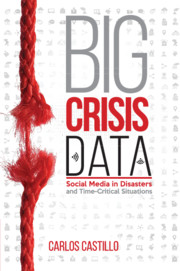Book contents
- Frontmatter
- Contents
- Preface
- Acknowledgments
- 1 Introduction
- 2 Volume: Data Acquisition, Storage, and Retrieval
- 3 Vagueness: Natural Language and Semantics
- 4 Variety: Classification and Clustering
- 5 Virality: Networks and Information Propagation
- 6 Velocity: Online Methods and Data Streams
- 7 Volunteers: Humanitarian Crowdsourcing
- 8 Veracity: Misinformation and Credibility
- 9 Validity: Biases and Pitfalls of Social Media Data
- 10 Visualization: Crisis Maps and Beyond
- 11 Values: Privacy and Ethics
- 12 Conclusions and Outlook
- Bibliography
- Index
- Terms and Acronyms
5 - Virality: Networks and Information Propagation
Published online by Cambridge University Press: 05 July 2016
- Frontmatter
- Contents
- Preface
- Acknowledgments
- 1 Introduction
- 2 Volume: Data Acquisition, Storage, and Retrieval
- 3 Vagueness: Natural Language and Semantics
- 4 Variety: Classification and Clustering
- 5 Virality: Networks and Information Propagation
- 6 Velocity: Online Methods and Data Streams
- 7 Volunteers: Humanitarian Crowdsourcing
- 8 Veracity: Misinformation and Credibility
- 9 Validity: Biases and Pitfalls of Social Media Data
- 10 Visualization: Crisis Maps and Beyond
- 11 Values: Privacy and Ethics
- 12 Conclusions and Outlook
- Bibliography
- Index
- Terms and Acronyms
Summary
The phrase “Twitter revolution” was coined in 2009 to describe the role of Twitter in “viral” calls to demonstrations against fraud in elections in Moldova and Iran. Since then, the rapid propagation of information through social media and mobile text messages has played an important role in the recruitment for protests in the Arab world, Europe, and America (González-Bailón et al., 2011). This rapid propagation has also been observed during disasters; for instance reposting activity has been observed to increase significantly in these situations (Starbird and Palen, 2010). Adistinctive feature that is a consequence of these processes is the appearance of explosive “bursts” of messages that reach large masses of people in a relatively short time frame.
Sociograms, which are graphs in which nodes represent people and edges represent social connections, started to be recorded and analyzed systematically in the early 1930s (Moreno, 1934). Currently, sociograms having hundreds of millions of nodes, which we now identify with social networks, continue to fuel the growth of an enormous body of research that includes work by sociologists, psychologists, communication scholars, physicists, computer scientists, and interdisciplinary teams. In addition to holding connections among users, current
social networking sites allow the creation of information networks, graphs in which nodes receive and disseminate information to other nodes through links. Social networks are a defining element of social media, and graph theory provides a theoretical foundation for studying social networks, including aspects such as the mechanism for the formation of online connections and the propagation of information online.
This chapter studies two interrelated aspects of social media during crises from a graph-theory perspective. First, there are structural properties of social and information networks that allow us, for instance, to measure certain properties about the users or groups of users who create or propagate information (§5.1). Second, there are particular types of information cascades – the history of propagation of a particular content on a network (§5.2) that can help us, for instance, determine the characteristics of messages, groups of messages, and users (§5.3).
Crisis Information Networks
Social media and other online systems include social networks in two ways: explicitly or implicit, also known as articulated or behavioral, respectively.
Explicit (articulated) social networks are created by people specifying who they are connected with, for instance by adding someone as a “friend,” or by “following” someone in social media.
- Type
- Chapter
- Information
- Big Crisis DataSocial Media in Disasters and Time-Critical Situations, pp. 68 - 78Publisher: Cambridge University PressPrint publication year: 2016



